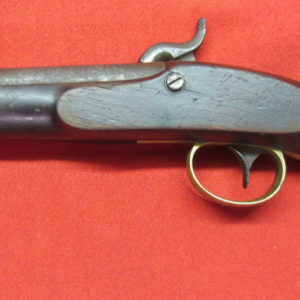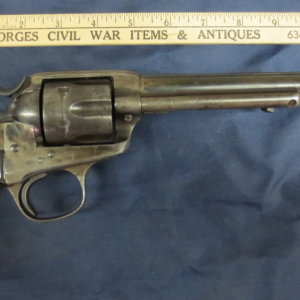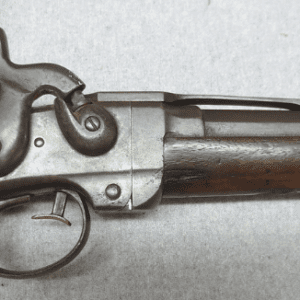Description
This is a fine example of one of the most popular and reliable percussion carbines of the Civil War era. Incredibly accurate and easy to maintain, the Sharps carbine saw battle action all across the United States for many decades and was used by units of both sides. This example has fine wood, crisp markings and an excellent bore.
According to data verified by Springfield Research Service, this example falls in the range of serial numbers of carbines issued to the 10th Illinois Cavalry. This is a fine addition to ANY Civil War collection and investment grade overall.
The Regiment was organized at Camp Butler in September 1861 and was one of the few Cavalry Regiments to have its own 12 member band. From its origin until 1864 each member of the Regiment owned his own horse after then the horses were provided by the Government.
- January, 1862 moved from Camp Butler to Quincy to continue drilling
- March 13, 1862 moved by steamer to Benton Barracks in Missouri
- April 1, 1862 the Third Battalion (Companies C, F, I, and M) of the 10th Cavalry, commanded by Major Marshall Stephenson of Springfield left by rail for Rolla, Mo. They were followed a few days later by the Second Battalion ( Companies B, E, H and L) commanded by Major Joseph S. Smith of Springfield and the First Battalion (Companies A, D, G, and K) commanded by Major Elvis P. Shaw of Paris, Illinois.
- From Rolla the Regiment marched to Springfield, Mo. (As opposed to Infantry Regiments, Cavalry Regiments were often divided into Battalions and the Battalions in each Regiment might operate independently.)
- June 15, 1862- The First Battalion detached and joined the forces of Major General S. R. Curtis at Jacksonport, Arkansas.
History of First Battalion. 10th Illinois Cavalry
Marched to Helena, Ark, July 4-12, 1862, fighting en route at Cotton Plant, Ark. on July 7. On August 6, moved to Old Town Landing, Ark. and remained there until October 6 when they marched back to Helena. Sent expeditions to:
- mouth of White River November 16-20
- Oakland, Miss. November 27-December 7
- Arkansas Post, Ark.-January 11, 1863
- Yazoo Pass -February 24-April 8, 1863
Siege operations against Vicksburg, Miss.-April-July
- Richmond, La. June 6
- Milliken’s Bend and Young’s Point La. June 6-7
- Expedition Young’s Point to Richmond June 14-16
Moved back to Helena, Ark., July and rejoined Regiment near Wittsburg, Ark., August 1, 1863.
History of Second and Third Battalions -10th Ill Cav
July 8, 1862-The Second and Third Battalions marched to Keetsville, Mo. and returned to Springfield, Mo. by July 20 Vera Cruz, Mo. August 10 Marshfield, Mo.
August 16-Headquarters remained at Marshfield until November 1862. During this time detachments were stationed at Sands Springs, Hartsville, and Clark’s Mills, Mo. and patrolled southwest Missouri into Arkansas.
November 14, 1862 the Second and Third battalions were made part of the Army of the Frontier and moved to Wilson Creek Mo. , brigaded with the 1st Iowa Cavalry, 2nd Wisconsin Cavalry and the 8th Missouri Cavalry. Later that month the Army of the Frontier, under Colonel Dudley Wickersham of Springfield raided Yellville, Ark and returned to Wilson’s Creek, a ride of 250 miles in 5 days.
December 4, 1862 -The Second and Third Battalions became part of an army commanded by Major General F. J. Herron and marched to reenforce General J. G. Blunt’s forces at Cane Hill, Ark. On December 6 the Brigade left the infantry and rode 50 miles to report to General Blunt at Cane Hill. On the morning of the 7th Colonel Wickersham was ordered to Rhea’s mill, Ark. to guard General Blunt’s supply train. The Brigade learned that General Herron was engaged in battle at Prairie Grove, Ark. headed to that town and entered the battle on the left rear flank of the enemy about 3 PM. Since the cavalry was armed with sabers and revolvers only they were assigned to support the Union artillery. The next day the Brigade protected the Union supply train to Fayetteville, Ark., then returned to join in the pursuit of the Confederate army to Van Buren, Ark.
January, 1863, the Second Battalion (Companies B, E, H, and L.) under Major Joseph S. Smith was transferred to the Division of General Totten at Huntsville, Ark., thrity miles to the east, and moved with this Division to Flat Creek, Mo..The Third Battalion remained at Fayetteville and sent detachments south into the Boston Mountains, defeating Rebels at Van Buren and Frog Bayou.
In March, 1863 the Second and Third Battalions rejoined and moved together to Rolla, Mo. It was at this time the the Regiment finally received carbines and was armed with Hall carbines, Sharps carbines, Colt revolvers, Remington revolvers, Savage revolvers, Starr revolvers and Dragoon sabers.
April, 1863- the Second and Third Battalions in an expedition under command of General William Vandever participated in a expedition to relieve Cape Girardeau, Mo. and drove the Rebel forces from Southeast Missouri.
May, 1863-the two Battalions were transferred to Pilot Knob, Missouri as part of a cavalry division, Department of the Missouri. The 10th Illinois was assigned to the Second Brigade, First Cavalry Division with Colonel Dudley Wickersham commanding the Brigade and Lt. Col. Stuart commanding the Battalions. On July 1, the expedition left Arcadia, Mo. and marched toward Little Rock, Arkansas.
First, Second & Third Battalions
August 1, 1863 the First Battalion joined the Second and Third Battalion near Wittsburg, Ark.
September 10, 1863-the Regiment with the First Cavalry Division fought at Bayou Fouche and at the fall of Little Rock, Arkansas. They pursued the Rebels on the 11th and 12th, returned to Little Rock on the 13th.
January, 1864-The Regiment received from Mrs. E. S. Turner, of the Soldiers Christian Association, Chicago a silk National flag, which on disbandment of the Regiment was deposited with the Adjutant General of the State of Illinois.
In February the three year enlistments expired and the men of the Regiment who reenlisted went home on a thirty days’ veteran furlough. They were welcomed home by Governor Yates in Springfield then returned to their homes. The veterans of the Regiment reunited at Camp Butler and left for Nashville, Tenn. on March 17, 1864. From there they were transferred to Little Rock but arrived without arms or horses. They were issued muskets and supplied with a six-gun battery to defend the city. Meanwhile the non-veterans of the Regiment were in Louisiana as a part of General Steele’s expedition to assist General Nathaniel Banks in the Red River expedition. The Regiment, veterans and non-veterans, were reunited at Little Rock and remained there until July 1864. They were then transferred to Huntsville, Arkansas: in September moved to Austin, Arkansas and in November to Brownsville, Arkansas.
In January, 1865 the men of the 10th Illinois Cavalry were consolidated into nine companies and the men of the 15th Illinois Cavalry into three companies and all reorganized into the Tenth Illinois Veteran Volunteer Cavalry.
The consolidated 10th Illinois Cavalry was ordered to New Orleans in mid-March of 1865 and was transferred by steamer arriving at Greenville La. April 1. On April 15, when word reached the Regiment of the assassination or President Lincoln, they were ordered into New Orleans as a provost guard to police the city and prevent possible retaliation of the Union forces against the Southern population. During this time the rebel ram Webb attempted escape down the Mississippi to the sea but, finding this impossible was run aground ten miles below New Orleans. The crew attempted to escape but was captured by a detachment of the 10th Cavalry Regiment.
June 6, 1865 the Regiment was ordered by boat up the Red River to Shreveport, Louisiana. It left Shreveport July 8, as part of the Second Brigade, First Cavalry Division under command of Major General Wesley Merritt and arrived at San Antonio, Texas on August 1 having marched five hundred miles in 3 1/2 weeks. November 22 the Regiment was mustered out of service and sent north. They were without horses and marched to Columbus, Texas and boarded a train for Houston, then a steamer for New Orleans and Cairo, Illinois. There they boarded cattle cars on the Illinois Central Railroad for Camp Butler. They were discharged on January 6, 1866.
During its term of service the Regiment lost 1 Officer and 24 Enlisted men killed and 3 Officers and 262 Enlisted men by disease, accidents and Confederate imprisonment.






